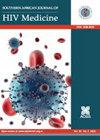Motor lumbosacral radiculopathy in HIV-infected patients
IF 1.6
4区 医学
Q4 INFECTIOUS DISEASES
引用次数: 3
Abstract
Background This study is a review of the clinical findings and treatment outcome of 11 HIV-infected patients with motor lumbosacral radiculopathy. Objectives To describe the clinical, laboratory, electrophysiological features and treatment outcome in HIV-infected motor lumbosacral radiculopathy which is a rare manifestation of HIV. Method A retrospective review of HIV-infected patients with motor lumbosacral radiculopathy was performed at Inkosi Albert Luthuli Central Hospital (IALCH), Durban, South Africa between 2010 and 2015. Results Eleven black African patients met the inclusion criteria. There were six women. The median age was 29 years, the interquartile range (IQR) was 23–41 years, the median duration of symptom progression was 6.5 months (IQR 3–7.5 months). The median CD4 count was 327 cells/µL (IQR 146–457). The cerebrospinal fluid (CSF) median polymorphocyte count was 0 cells/µL (IQR 0 cells/µL – 2 cells/µL), lymphocyte count was 16 cells/µL (IQR 1 cells/µL – 18 cells/µL), glucose level was 3.1 mmol/L (IQR 2.8 mmol/L – 3.4 mmol/L) and protein level was 1.02 g/dL (IQR 0.98 g/dL – 3.4 g/dL). All patients were treated with corticosteroid therapy. Ninety-one per cent recovered fully within 6 months of treatment, the median time for recovery was 3.4 months (IQR 1.8–5.6 months). There were no relapses during the 18-month follow-up. Conclusion HIV-infected patients with motor lumbosacral radiculopathy responded to corticosteroids, with no relapses during the 18-month follow-up period.hiv感染患者的运动腰骶神经根病
本研究回顾了11例hiv感染的运动腰骶神经根病患者的临床表现和治疗结果。目的探讨HIV感染的运动腰骶神经根病的临床、实验室、电生理特征及治疗结果。方法回顾性分析2010 - 2015年在南非德班Inkosi Albert Luthuli中心医院(IALCH)治疗的hiv感染的运动腰骶神经根病患者。结果11例非洲黑人患者符合纳入标准。有六个女人。中位年龄29岁,四分位间距(IQR) 23 ~ 41岁,症状进展中位持续时间6.5个月(IQR 3 ~ 7.5个月)。中位CD4计数为327个细胞/µL (IQR 146-457)。脑脊液(CSF)中位多形态细胞计数为0个细胞/µL (IQR为0个细胞/µL - 2个细胞/µL),淋巴细胞计数为16个细胞/µL (IQR为1个细胞/µL - 18个细胞/µL),葡萄糖水平为3.1 mmol/L (IQR为2.8 mmol/L - 3.4 mmol/L),蛋白质水平为1.02 g/dL (IQR为0.98 g/dL - 3.4 g/dL)。所有患者均接受皮质类固醇治疗。91%患者在治疗6个月内完全康复,中位康复时间为3.4个月(IQR 1.8 ~ 5.6个月)。随访18个月无复发。结论艾滋病毒感染的运动腰骶神经根病患者对皮质类固醇有反应,在18个月的随访期间无复发。
本文章由计算机程序翻译,如有差异,请以英文原文为准。
求助全文
约1分钟内获得全文
求助全文
来源期刊
CiteScore
2.80
自引率
11.80%
发文量
41
审稿时长
>12 weeks
期刊介绍:
The Southern African Journal of HIV Medicine is focused on HIV/AIDS treatment, prevention and related topics relevant to clinical and public health practice. The purpose of the journal is to disseminate original research results and to support high-level learning related to HIV Medicine. It publishes original research articles, editorials, case reports/case series, reviews of state-of-the-art clinical practice, and correspondence.

 求助内容:
求助内容: 应助结果提醒方式:
应助结果提醒方式:


